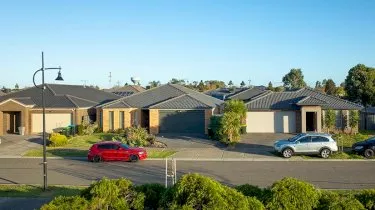Invest
House price slowdown continues as growth in Sydney and Melbourne grinds to a halt
Invest
House price slowdown continues as growth in Sydney and Melbourne grinds to a halt
Sydney has suffered its first monthly decline in house prices since 2020.
House price slowdown continues as growth in Sydney and Melbourne grinds to a halt
House prices in Sydney have declined for the first time since September 2020, according to CoreLogic’s home value index for February amid a slowdown in growth across the country.
Prices in Sydney dipped by 0.1 per cent during the month, while Melbourne house prices remained flat after the city’s growth streak was first broken in December last year.
Nationally, house prices lifted for the 17th consecutive month with a rise of 0.6 per cent. This was the slowest rate of growth since October 2020 and down from an increase of 1.1 per cent recorded in January and the cyclical peak of 2.8 per cent seen in March 2021.
CoreLogic director of research Tim Lawless said the slower growth conditions are linked to impending rate hikes.

“The pace of growth in housing values started to ease in April last year, when fixed-term mortgage rates began to face upwards pressure, fiscal support was expiring and housing affordability was becoming more stretched,” he explained.
“With rising global uncertainty and the potential for weaker consumer sentiment amidst tighter monetary policy settings, the downside risk for housing markets has become more pronounced in recent months.”
Annual growth fell from 22.4 per cent in January to 20.6 per cent in February, and CoreLogic suggested that January’s annual growth rate would likely remain the peak of this cycle.
Growth rates remain diverse across Australia’s capital cities and regions with significant rises seen in Brisbane (1.8 per cent), Adelaide (1.5 per cent) and Hobart (1.2 per cent) last month.
On a quarterly basis, prices are up 7.2 per cent in Brisbane and 6.4 per cent in Adelaide compared to growth of 0.2 per cent in Melbourne and 0.8 per cent in Sydney.
Regional growth continues to outpace the cities with prices moving 1.6 per cent higher in the combined regional areas versus growth of 0.3 per cent in the combined capitals.
Quarterly growth for the regions was 5.7 per cent compared to 1.8 per cent for the capitals. While still strong, this represented a fall from a cyclical peak of 6.6 per cent in April last year.
“Regional housing markets aren’t immune from the higher cost of debt as fixed-term mortgage rates rise. These markets are also increasingly impacted by worsening affordability constraints as housing prices consistently outpace incomes,” said Mr Lawless.
“However, demographic tailwinds, low inventory levels and ongoing demand for coastal or treechange housing options are continuing to support strong upwards price pressures across regional housing markets.”
The Commonwealth Bank and Regional Australia Institute recently reported that net migration to regional areas had more than double over the past two years.

Property
The 2026 Suburb Thesis: A case study in turning trend lists into investable strategy
A new crop of ‘suburbs to watch’ is hitting headlines, but translating shortlist hype into bottom-line results requires more than a map and a mood. This case study shows how a disciplined, data-led ...Read more

Property
From signals to settlements: A case study in turning property insight into investable action
Investor confidence is rebuilding, first-home buyers are edging back, and governments are pushing supply — yet most property players still struggle to convert signals into decisive movesRead more

Property
Australia’s rental choke point: why record-low vacancies are now a boardroom issue
A tightening rental market is no longer just a housing story—it’s a macro risk, a labour challenge and a strategic opening for capital. With vacancies near historic lows and rents still rising, ...Read more

Property
Rents are rewriting the inflation playbook: what record‑low vacancies mean for Australian business
Australia’s rental market is so tight that housing costs are now a primary transmission channel for inflation and interest rates. This isn’t just a property story; it’s a business risk story—affecting ...Read more

Property
Off-market real estate is going mainstream — and changing the rules of dealmaking
With public listings tight and sales still climbing, Australia’s investors are shifting to off-market channels that reward speed, networks and data advantage. The playbook is closer to private equity ...Read more

Property
Australia’s rental squeeze is now a business problem: inflation, capacity and the new growth calculus
Record-low rental vacancies are no longer just a social headline – they’re reshaping cost structures, wage dynamics and capital allocation across corporate Australia. With economists warning of a ...Read more

Property
Rents Are Repricing Australia Inc: What record‑low vacancies mean for inflation, talent and strategy
Australia’s rental market has slipped into a vacancy desert, and it’s not just tenants feeling the heat. Persistently tight supply is pushing up rents, embedding services inflation and complicating ...Read more

Property
Young buyers poised for a comeback as 5% First Home Guarantee takes effect
In a move set to reshape the Australian property landscape, the government’s revamped First Home Guarantee is poised to open the doors of homeownership to a new generation of young AustraliansRead more

Property
The 2026 Suburb Thesis: A case study in turning trend lists into investable strategy
A new crop of ‘suburbs to watch’ is hitting headlines, but translating shortlist hype into bottom-line results requires more than a map and a mood. This case study shows how a disciplined, data-led ...Read more

Property
From signals to settlements: A case study in turning property insight into investable action
Investor confidence is rebuilding, first-home buyers are edging back, and governments are pushing supply — yet most property players still struggle to convert signals into decisive movesRead more

Property
Australia’s rental choke point: why record-low vacancies are now a boardroom issue
A tightening rental market is no longer just a housing story—it’s a macro risk, a labour challenge and a strategic opening for capital. With vacancies near historic lows and rents still rising, ...Read more

Property
Rents are rewriting the inflation playbook: what record‑low vacancies mean for Australian business
Australia’s rental market is so tight that housing costs are now a primary transmission channel for inflation and interest rates. This isn’t just a property story; it’s a business risk story—affecting ...Read more

Property
Off-market real estate is going mainstream — and changing the rules of dealmaking
With public listings tight and sales still climbing, Australia’s investors are shifting to off-market channels that reward speed, networks and data advantage. The playbook is closer to private equity ...Read more

Property
Australia’s rental squeeze is now a business problem: inflation, capacity and the new growth calculus
Record-low rental vacancies are no longer just a social headline – they’re reshaping cost structures, wage dynamics and capital allocation across corporate Australia. With economists warning of a ...Read more

Property
Rents Are Repricing Australia Inc: What record‑low vacancies mean for inflation, talent and strategy
Australia’s rental market has slipped into a vacancy desert, and it’s not just tenants feeling the heat. Persistently tight supply is pushing up rents, embedding services inflation and complicating ...Read more

Property
Young buyers poised for a comeback as 5% First Home Guarantee takes effect
In a move set to reshape the Australian property landscape, the government’s revamped First Home Guarantee is poised to open the doors of homeownership to a new generation of young AustraliansRead more









